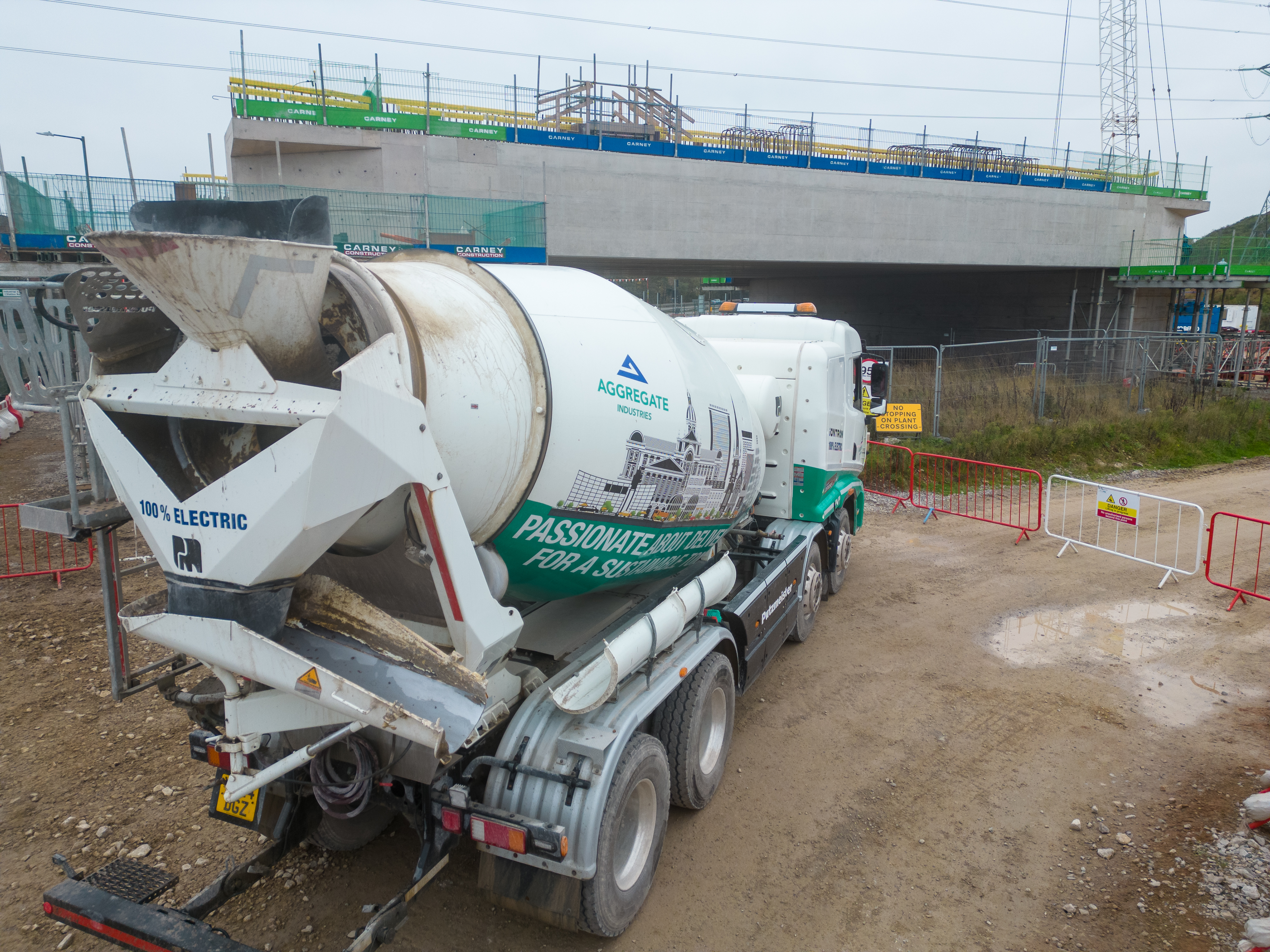Balfour Beatty VINCI and its UK materials suppliers have now provided over one million cubic metres of concrete for HS2 in the West Midlands as the railway’s network of viaducts and bridges continues to take shape.
With a total of 1.9 million cubic metres of concrete needed for the 90km stretch of railway structures, this means over 50% of the required concrete has been used.
Balfour Beatty VINCI has three concrete suppliers, keeping their order books full for the foreseeable future, and supporting over 250 jobs. Aggregate Industries, Tarmac and Cemex have batched and delivered the one million cubic metres of concrete, with the milestone achieved on the Chattle Hill structure at the Delta Junction in North Warwickshire.
There are 11 local batching plants supplying the concrete, five of which are on HS2 sites. The entire concrete programme in the West Midlands is managed by a dedicated Balfour Beatty VINCI team at HS2’s Kingsbury site near Lea Marston.
The use of low carbon concrete mixes is an integral part of Balfour Beatty VINCI’s concrete supply strategy. High proportions of secondary materials - namely ground granulated blast furnace slag (GGBS) as part of the total cementitious content is embedded into the design and specification for all mixes.
Balfour Beatty VINCI has worked with its supply chain to optimise mixes based on the performance required, maximising the content of GGBS and minimising total cementitious contents to reduce carbon and cost.
The mixes supplied cover a wide range of uses from deep foundations up to 30 metres placed via tremie pipes, large structural elements where the concrete is pumped into place, to the onsite precast factories producing segments for both tunnel lining and the large viaduct spans.
A number of fully electric trucks are being used to transport the concrete to sites, with two of HS2’s batching plants able to run off semi-battery technology, further reducing the project’s carbon footprint.
Balfour Beatty VINCI and their suppliers have also implemented a digital measuring system – VERIFI – which enables real-time monitoring, measurement and management of fresh concrete during transportation. This eliminates waste, cuts carbon and improves productivity.
Chris Jones, Senior Construction Manager at Balfour Beatty VINCI Joint Venture said: “The planning, communication and logistics management needed to achieve this milestone cannot be underestimated. Working in partnership with our three concrete suppliers, the team have kept this massive operation moving, supporting delivery of HS2’s construction programme in the region.
“Carbon reduction is a big part of our materials strategy, and we’ve worked closely with our supply chain to minimise the total cementitious contents in order to cut carbon and cost.”
Jon Knights, Materials and Durability Lead at HS2 said: “The operation to manage the materials needed to build HS2’s structures is hugely complex, so this milestone is a great achievement for the whole team.
“With more than half the concrete poured for structures in the West Midlands, we’re well on the way to completing the viaducts and bridges that will carry the country’s new high-speed railway through the region.”
Aggregate Industries are supplying concrete for the Delta Junction structures, where the scale of HS2’s construction programme is now clearly visible. A network of 13 viaducts is being built over the complex network of motorways, railway lines and rivers in the North Warwickshire area.
The Chattle Hill structure - where the milestone was achieved - will carry four HS2 tracks over the A446 Lichfield Road on the mainline of the railway between London and Handsacre. The structure is 165m long, 8.3m high and 23m wide. Over 4,100 cubic metres out of a total of around 10,200 cubic metres of concrete have been used for the structure to date.
The A446 diversion to take the road under the new Chattle Hill structure was completed at the end of October 2024, with the second phase of construction set to start. This includes the central reservation piers, northern abutments and decks that will span over the A446.
Tarmac is supplying to the southern end of the route through Warwickshire, along with Washwood Heath and the Curzon approaches viaducts in Birmingham. Cemex are also providing material in Birmingham, as well as for structures being built in Staffordshire.
Construction of HS2 continues at pace between the West Midlands and London, with the programme now supporting more than 31,000 jobs. When complete, HS2 services will run between London and the West Midlands on a dedicated high-speed line before reaching destinations further north via the existing West Coast Main Line.
ENDS
All non-media related enquiries should be directed to +44 (0)20 7216 6800 or info@balfourbeatty.com
Notes to editors:
- Balfour Beatty is a leading international infrastructure group with over 26,000 employees driving the delivery of powerful new solutions, shaping thinking, creating skylines and inspiring a new generation of talent to be the change-makers of tomorrow.
- We finance, develop, build, maintain and operate the increasingly complex and critical infrastructure that supports national economies and deliver projects at the heart of local communities.
- Over the last 114 years we have created iconic buildings and infrastructure all over the world. Currently, we are working to deliver Hinkley Point C, the first UK nuclear power station in a generation; constructing the world-class arts and cultural facility, the Lyric Theatre, in Hong Kong; and designing, building, financing, operating and maintaining the Automated People Mover superstructure at one of the busiest airports in the world, Los Angeles International Airport.

eMixer at Chattle Hill for the concrete pour milestone
